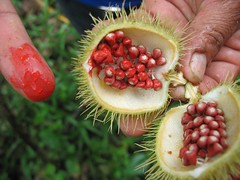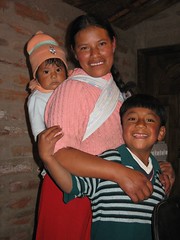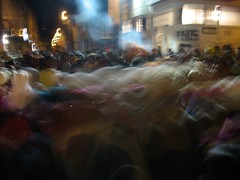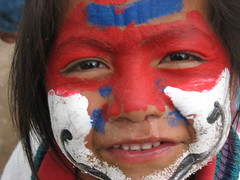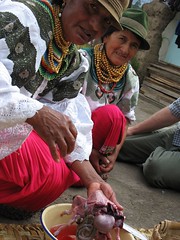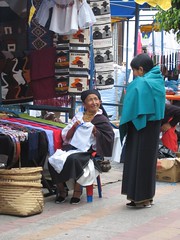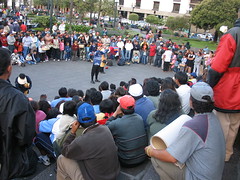El Oriente, a.k.a. the Amazon (part 1)
To the east of the Andean highlands that streak the center of Ecuador, the terrain slopes abruptly. With its decent, the air becomes thicker, the plants larger, and life ripens more intensely. The haphazardly constructed road snakes its way down from the Quito into el Oriente, home to the tributaries of the Amazon.
Fueling the world’s curiosity, stories of Amazonian women and anacondas have earned a life of their own, set free from their birthplace in the jungle. But it is not only outside of the jungle that such stories reside. They hang in the dense jungle air, permeating the rhythms of life: headhunters, spear wielding natives, forest spirits, brujeria (black magic), the powers of medicinal plants, indigenous groups that have not made contact with the West.
In the ecotourism lodge run by the village of Caipiruna, we got our first, though somewhat prepackaged taste of life in these jungle communities. We wandered through the thickets, examining medicinal plants and marveling at the verdant growth upon growth of jungle life, returning by water on long boats hollowed out of tree trunks, followed by a dip in the river. During meals we were accompanied by a baby tarantula in the corner of the open aired dining area. After blow dart gun practice, using an intricately made 8 ft hollow tube, we took a look at their traditional style of basket weaving, followed by an evening of traditional music and dancing.
Returning to their cabin later that evening, a student noticed that her mosquito net had been moved. Upon further examination, it seemed that a thief had come through several rooms, found peoples wallets in their bags, taken a $20 bill per person, and returned everything to its original position. While launching us into the suspicion of a detective novel, the crime struck a deeper cord, preying on the poignant reality that a westerner with so much money would likely not notice the difference; And so concluded the double edged lessons of the tourism industry.
The following day, we set forth to Venecia, a village on the banks of the Napo where Todd, a professor at the University of Arizona had set up a field site. The child of missionary doctors, Todd had grown up in the area, and served as a bridge between local and western culture. Over the course of several talks, he explained the local health paradigm; the flow of energy through the mountain and river, the powers of the shaman, the seductive forest spirits, the 90% homicide rate due to invisible darts shot at the heart. He offered a taste of this protected culture.
It was Todd that led us up the river where Kyle fell in love with a waterfall, it was Todd to took us to sleep on a platform in the depths of the jungle, and it was Todd that took us to visit the Shaman where Kyle was cleansed for his own protection. . .to be continued in part 2.
Fueling the world’s curiosity, stories of Amazonian women and anacondas have earned a life of their own, set free from their birthplace in the jungle. But it is not only outside of the jungle that such stories reside. They hang in the dense jungle air, permeating the rhythms of life: headhunters, spear wielding natives, forest spirits, brujeria (black magic), the powers of medicinal plants, indigenous groups that have not made contact with the West.
In the ecotourism lodge run by the village of Caipiruna, we got our first, though somewhat prepackaged taste of life in these jungle communities. We wandered through the thickets, examining medicinal plants and marveling at the verdant growth upon growth of jungle life, returning by water on long boats hollowed out of tree trunks, followed by a dip in the river. During meals we were accompanied by a baby tarantula in the corner of the open aired dining area. After blow dart gun practice, using an intricately made 8 ft hollow tube, we took a look at their traditional style of basket weaving, followed by an evening of traditional music and dancing.
Returning to their cabin later that evening, a student noticed that her mosquito net had been moved. Upon further examination, it seemed that a thief had come through several rooms, found peoples wallets in their bags, taken a $20 bill per person, and returned everything to its original position. While launching us into the suspicion of a detective novel, the crime struck a deeper cord, preying on the poignant reality that a westerner with so much money would likely not notice the difference; And so concluded the double edged lessons of the tourism industry.
The following day, we set forth to Venecia, a village on the banks of the Napo where Todd, a professor at the University of Arizona had set up a field site. The child of missionary doctors, Todd had grown up in the area, and served as a bridge between local and western culture. Over the course of several talks, he explained the local health paradigm; the flow of energy through the mountain and river, the powers of the shaman, the seductive forest spirits, the 90% homicide rate due to invisible darts shot at the heart. He offered a taste of this protected culture.
It was Todd that led us up the river where Kyle fell in love with a waterfall, it was Todd to took us to sleep on a platform in the depths of the jungle, and it was Todd that took us to visit the Shaman where Kyle was cleansed for his own protection. . .to be continued in part 2.
